


A book which immediately ranks as one of the finest in chess history has just been published: Emanuel Lasker Denker Weltenbürger Schachweltmeister edited by Richard Forster, Stefan Hansen and Michael Negele (Berlin, 2009).

A few statistics first. A beautiful hardback, it comprises 1,079 large pages with 700 games, 1,600 diagrams and over 500 illustrations. The contributors include Robert Hübner (a chapter of more than 160 pages deeply analysing Lasker’s early games) and Victor Korchnoi (annotations to three games played in the final phase of Lasker’s career). Other highlights are excellently-researched chapters on Lasker’s family and childhood, his writings, his work as a mathematician and philosopher, his involvement in the games Laska, Go and bridge and his problems and studies.
The contributions have been skilfully brought together to create a serene, harmonious entity, complete with a detailed bibliography, indexes and other requisites of high scholarship. As the reader turns the pages, the surprises are unending. Page 201 reproduces a letter of condolence from Albert Einstein to Lasker’s widow, Martha. A discovery presented on pages 1054-1055 is a 1956 university thesis by George G. Gallagher, Doctor Emanuel Lasker A Psychobiography:
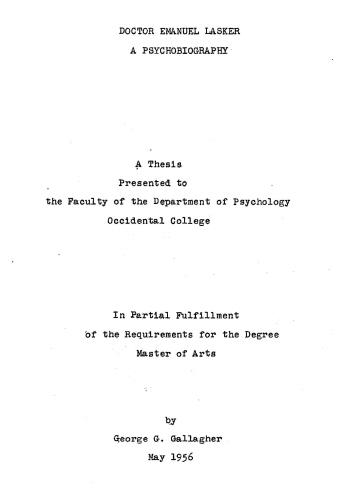
Emanuel Lasker Denker Weltenbürger Schachweltmeister having only just been published, we have merely been dipping into it and would not presume to offer any kind of formal review. Instead, with the generous permission of the editors, the present article will whet the appetite of potential readers by offering a selection from the 500 or so illustrations. We begin with a photograph from page 54, showing Lasker at the board with Max Frankel, a founder member of the Manhattan Chess Club:
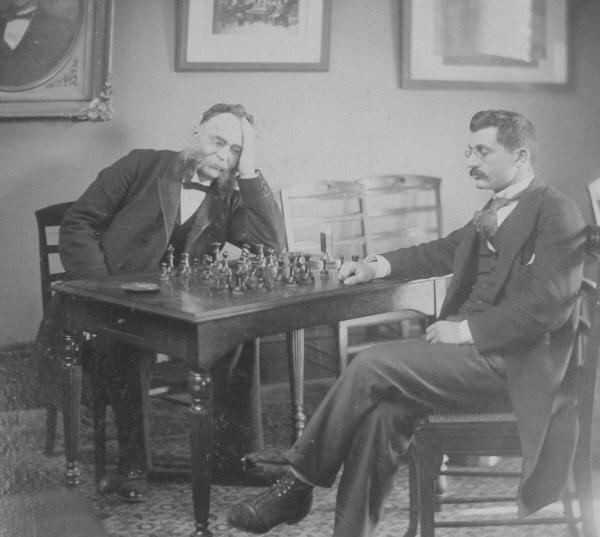
Another rare portrait, dated 1899, is on page 212:
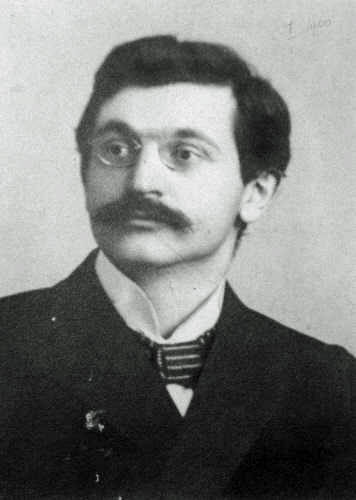
Among the documents which caught our eye, on pages 1007-1013, is a letter written by Lasker (Berlin, 4 October 1903) to Walter Penn Shipley. The extract below refers to a possible challenge by Tarrasch to a world championship match, and Lasker adds that if he wins that match he will ‘probably resign the title of champion which confers no rights of any sort but only exposes to challenges unrestrained by any condition’:
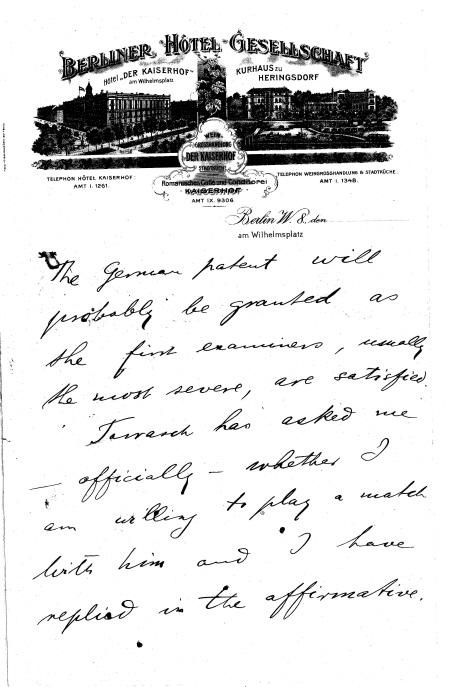
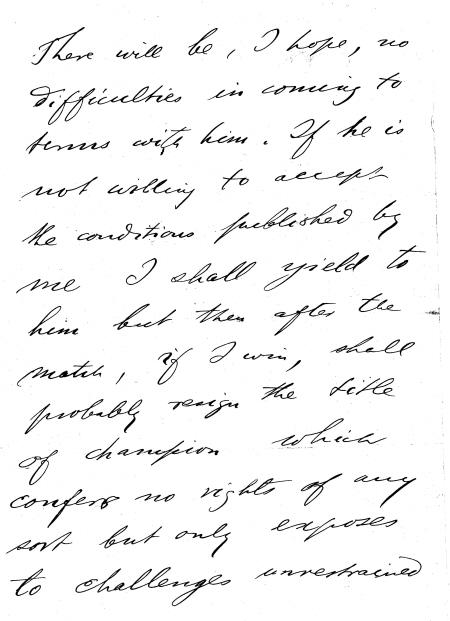
A particularly fine shot of Lasker, dated 1926, is on page 676:

The photograph below, from page 1029, shows Lasker with Nimzowitsch during a tournament in Berlin in spring, 1928:
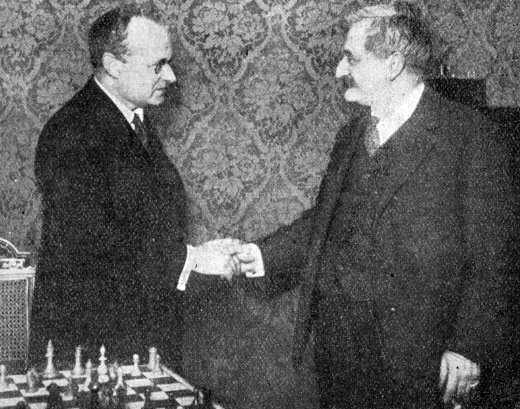
Another shot featuring Nimzowitsch (as well as Kmoch, Alekhine and Bogoljubow, during the 1934 world championship match) is on page 291:

Next, Lasker aboard the Westphalia in autumn 1928 (from page 995):
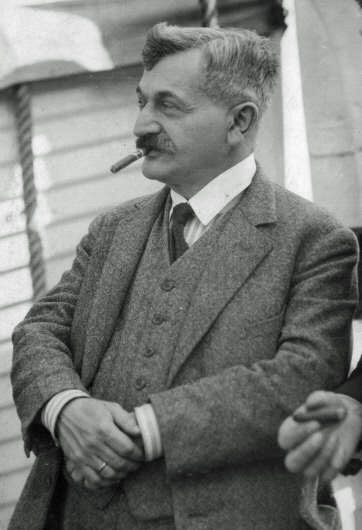
The last photograph chosen for inclusion here comes from page 1040 and is dated 1936:
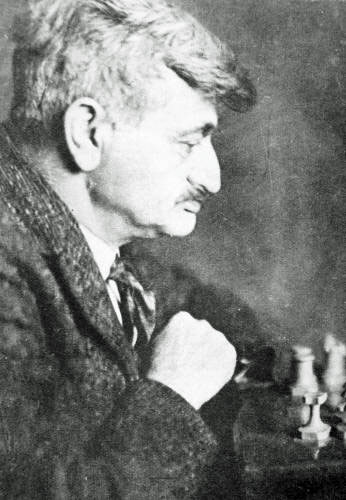
It is only proper that the full team of contributors to Emanuel Lasker Denker Weltenbürger Schachweltmeister should be listed here: Wolfgang Angerstein, Ralf Jürgen Binnewirtz, John W. Donaldson, Jürgen Fleck, Tony Gillam, Jesús Bayolo Gonzalez, Bernd Gräfrath, Roberto Mayor Gutiérrez, John S. Hilbert, Robert Hübner, Peter de Jong, Karl Kadletz, Wolfgang Kamm, Victor Korchnoi, Thomas Lemanczyk, Isaak M. Linder, Vladimir Linder, Tomasz Lissowski, Egbert Meissenburg, Michael Negele, Susanna Poldauf, Toni Preziuso, Joachim Rosenthal, Raj Tischbierek, Robert van de Velde and Hans-Christian Wohlfarth. Richard Forster was the editor-in-chief, supported by Ralf Jürgen Binnewirtz as the technical assistant. The layout (which includes fine diagrams for Laska and Go) was by Ulrich Dirr.
When browsing through the volume it is impossible not to derive both pleasure and pride from such a magnificent tribute being produced to one of the greatest chessplayers of all time. The present, relatively brief, pictorial feature cannot, even remotely, do justice to a book which will be treasured by anyone with an interest in our game’s history, including those with no knowledge of German.
Further information about Emanuel Lasker Denker Weltenbürger Schachweltmeister is available at the webpage of the Emanuel Lasker Gesellschaft. The book can also be acquired direct from the publisher, Exzelsior Verlag.
Submit information or suggestions on chess explorations
All ChessBase articles by Edward Winter
 Edward
Winter is the editor of Chess
Notes, which was founded in January 1982 as "a forum for aficionados
to discuss all matters relating to the Royal Pastime". Since then, nearly 6,400
items have been published, and the series has resulted in four books by Winter:
Chess
Explorations (1996), Kings,
Commoners and Knaves (1999), A
Chess Omnibus (2003) and Chess
Facts and Fables (2006). He is also the author of a monograph
on Capablanca (1989).
Edward
Winter is the editor of Chess
Notes, which was founded in January 1982 as "a forum for aficionados
to discuss all matters relating to the Royal Pastime". Since then, nearly 6,400
items have been published, and the series has resulted in four books by Winter:
Chess
Explorations (1996), Kings,
Commoners and Knaves (1999), A
Chess Omnibus (2003) and Chess
Facts and Fables (2006). He is also the author of a monograph
on Capablanca (1989).
Chess Notes is well known for its historical research, and anyone browsing in its archives will find a wealth of unknown games, accounts of historical mysteries, quotes and quips, and other material of every kind imaginable. Correspondents from around the world contribute items, and they include not only "ordinary readers" but also some eminent historians – and, indeed, some eminent masters. Chess Notes is located at the Chess History Center. Signed copies of Edward Winter's publications are currently available.